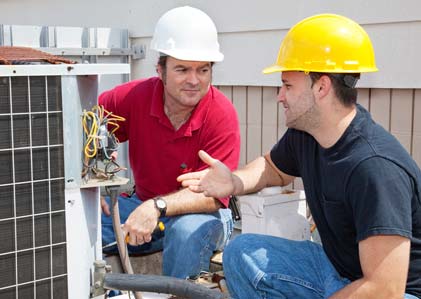Steps to Become an HVAC Installer
While it’s true that there are specific career pathways to becoming HVAC installers, the following steps exemplify a common career trajectory for entering the HVAC installer career.
Step 1: Earn a high school diploma or GED (four years)
Although there are no specific educational requirements, legally speaking, to become an HVAC installer, ONet Online (2022) indicates that more than 80 percent of HVAC professionals have at least a high school diploma or GED. Students should be sure to excel in math and science courses and if available should pursue vocational job-shadowing opportunities in the HVAC industry.
Step 2, option A: Pursue post-secondary training (two to four years)
After high school, many prospective HVAC installers choose to enroll in a post-secondary training program. These programs typically cover all HVAC technician roles, including installation.
For example:
Northeast Wisconsin Technical College
Northeast Wisconsin Technical College offers an associate of applied science (AAS) degree and a technical diploma in HVAC/R technology preparing students for developing, starting, servicing, repairing, and troubleshooting HVAC/R systems. Students will also be prepared for the EPA Refrigerant Handling Exam and will be able to earn certifications such as OSHA 10, CPR, and AED.
Admission requirements for the program include a completed application, high school transcript or equivalent, high school algebra or equivalent, and a cumulative high school or college grade point average of 2.6 or higher.
The AAS degree is made up of 65 credits, while the diploma comprises 53 credits. All credits from the technical diploma may be applied toward the associate degree. Sample some of the courses in the curriculum: HVAC/R refrigeration fund; HVAC/R electrical fundamentals; HVAC/R heating fundamentals; HVAC/R control circuits; HVAC/R systems service; HVAC/R design applications; and HVAC/R heating systems, among others.
Graduates from this program are prepared to begin careers in HVAC/R (refrigeration) as mechanical contractors, technicians, wholesale service representatives, commercial systems technicians, and industrial and residential systems technicians.
- Location: Green Bay, WI
- Accreditation: Higher Learning Commission (HLC)
- Expected Time to Completion: Two years
- Estimated Tuition: AAS ($11,568); diploma ($9,637)
University of Northwestern Ohio
UNOH offers an associate’s degree and a diploma program in HVAC/R technology. Combining classroom lectures with hands-on training in labs, these programs prepare students for entry-level positions in the HVAC/R industry by providing them with the necessary skills currently applicable to the industry.
The diploma consists of 61 credits, while the AAS degree comprises 88 credit-hours. As part of the program, students will delve into topics such as electronics and electrical; heat pumps; HVAC/R systems and controls; services and procedures; digital documents & spreadsheets; and customer relations automated management.
- Location: Lima, OH
- Accreditation: HVAC Excellence; PAHRA; and Higher Learning Commission (HLC)
- Expected Time to Completion: Diploma (16 months); AAS (20 months)
- Estimated Tuition: $1,700 per six-week session
Although the vast majority of HVAC programs are two-year associate degree programs, there are some bachelor’s degree programs in the United States such as:
Ferris State University
Students in the FSU bachelor of science in HVAC/R program are prepared with solid theoretical knowledge as well as extensive laboratory experience. The four-year degree builds on the coursework from the two-year associate degree in applied science degree in HVAC/R technology offering students the option of graduating with a two- or four-year degree in HVAC/R technology.
The BS degree program consists of 124 credit-hours including courses such as HVAC hydronic system select design; control theory and application; load analysis & energy modeling; direct digital control; commercial HVAC system design; and contracting issues in HVAC/R.
Graduates will be able to design industrial and commercial HVAC systems, program control sequences for specific HVAC systems, perform energy audits, and develop specs, estimates, economic cost analysis, and codes and standards.
- Location: Big Rapids, MI
- Accreditation: Higher Learning Commission (HLC)
- Expected Time to Completion: Four years
- Estimated Tuition: $467 to $505 per credit
Step 2, option B: Complete an apprenticeship (two to five years)
HVAC installers who want to join a labor union or who are ready to dedicate more years to hands-on training may choose to apply for an apprenticeship program in HVAC.
For example, the Local Union 25 in Rock Island, Illinois offers a highly selective five-year HVAC apprenticeship which consists of 10,000 hours of hands-on training and 1,250 hours of classroom training. During this time, apprentices are paid a percentage of a fully trained technician’s salary. This program is registered through the Bureau of Apprenticeship Training and the U.S. Department of Labor and upon completion of this program, apprentices earn journeyperson status.
Step 3: Obtain Environmental Protection Agency (EPA) Section 608 certification (timeline varies)
All HVAC technicians who work with refrigerants must earn the EPA section 608 certification. Section 608 training and certification are typically included in most HVAC training programs, but it is essential that HVAC installers earn this certification before beginning work.
There are four types of certifications: specializations in servicing small appliances (type I), servicing or disposing of high-pressure appliances (type II), servicing or disposing of low-pressure appliances (type III), and servicing all types of equipment (universal). It is worth noting that HVAC apprentices are exempt from EPA certification requirements so long as their work is closely and continuously supervised by a certified technician.
Step 4: Apply for state or local licensure (timeline varies)
Depending on the region where an HVAC installer works, state or local licensing in HVAC may be required before starting work. More details about licensing are available in the next section.
Step 5: Pursue further certifications (optional; timeline varies)
Further professional prospects may be available to HVAC installers who choose to pursue certification beyond what is required. These certifications are available from organizations like ESCO Group. This organization offers “stackable” progressive levels of certification in a pyramid model making certification accessible for professionals who are at different stages of their careers and certification levels. The base of the stackable certification pyramid begins with EPA certifications and the top-level certification offered is certified master HVAC/R educator.
For a full list of available certifications, check out the main HVAC certifications page.




